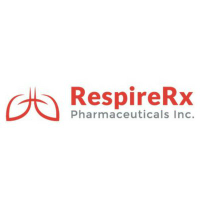
We could not find any results for:
Make sure your spelling is correct or try broadening your search.

RespireRX Pharmaceuticals Inc. is a biopharmaceutical company focused on the discovery and development of novel drug therapies for the treatment of sleep apnea, ADHD, spinal cord injury and other neurological conditions. RespireRX Pharmaceuticals Inc. is a biopharmaceutical company focused on the discovery and development of novel drug therapies for the treatment of sleep apnea, ADHD, spinal cord injury and other neurological conditions.
| Period | Change | Change % | Open | High | Low | Avg. Daily Vol | VWAP | |
|---|---|---|---|---|---|---|---|---|
| 1 | -0.0005 | -38.4615384615 | 0.0013 | 0.0025 | 0.0008 | 809327 | 0.00212487 | CS |
| 4 | 0.0001 | 14.2857142857 | 0.0007 | 0.0025 | 0.0006 | 1086106 | 0.00138769 | CS |
| 12 | -0.0012 | -60 | 0.002 | 0.0025 | 0.0004 | 722094 | 0.00142026 | CS |
| 26 | -0.0035 | -81.3953488372 | 0.0043 | 0.0045 | 0.0002 | 5285385 | 0.0018146 | CS |
| 52 | -0.00015 | -15.7894736842 | 0.00095 | 0.0069 | 0.0002 | 13590937 | 0.00248518 | CS |
| 156 | -0.012 | -93.75 | 0.0128 | 0.0191 | 0.0002 | 6367584 | 0.00226381 | CS |
| 260 | -0.0992 | -99.2 | 0.1 | 0.1499 | 0.0002 | 6226473 | 0.00485593 | CS |
 LTListener
9 minutes ago
LTListener
9 minutes ago
 meixatech
14 minutes ago
meixatech
14 minutes ago
 LTListener
15 minutes ago
LTListener
15 minutes ago
 LTListener
26 minutes ago
LTListener
26 minutes ago
 Dyno89
14 hours ago
Dyno89
14 hours ago
 meixatech
17 hours ago
meixatech
17 hours ago
 meixatech
20 hours ago
meixatech
20 hours ago
 Menace212
21 hours ago
Menace212
21 hours ago
 LTListener
21 hours ago
LTListener
21 hours ago
 bigtalan
1 day ago
bigtalan
1 day ago
 LTListener
1 day ago
LTListener
1 day ago
 Menace212
1 day ago
Menace212
1 day ago
 LTListener
1 day ago
LTListener
1 day ago
 Gladiator 83
1 day ago
Gladiator 83
1 day ago
 LTListener
2 days ago
LTListener
2 days ago
 LTListener
2 days ago
LTListener
2 days ago
 StocktonCA
2 days ago
StocktonCA
2 days ago
 meixatech
2 days ago
meixatech
2 days ago
 Menace212
2 days ago
Menace212
2 days ago
 Menace212
2 days ago
Menace212
2 days ago
 Menace212
2 days ago
Menace212
2 days ago
 LTListener
2 days ago
LTListener
2 days ago
 LTListener
2 days ago
LTListener
2 days ago
 meixatech
3 days ago
meixatech
3 days ago
 LTListener
3 days ago
LTListener
3 days ago
 LTListener
3 days ago
LTListener
3 days ago
 meixatech
3 days ago
meixatech
3 days ago
 LTListener
3 days ago
LTListener
3 days ago
 LTListener
3 days ago
LTListener
3 days ago
 LTListener
3 days ago
LTListener
3 days ago
 LEFTY1182
3 days ago
LEFTY1182
3 days ago
 meixatech
4 days ago
meixatech
4 days ago
 jacksonjohn
5 days ago
jacksonjohn
5 days ago
 Menace212
6 days ago
Menace212
6 days ago
 bigtalan
6 days ago
bigtalan
6 days ago

It looks like you are not logged in. Click the button below to log in and keep track of your recent history.
Support: +44 (0) 203 8794 460 | support@advfn.com
By accessing the services available at ADVFN you are agreeing to be bound by ADVFN's Terms & Conditions